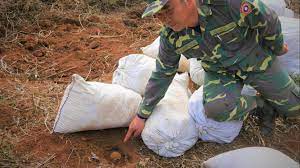01/02/2023 Laos
“If you ever come across anything suspicious like this item, please do not pick it up, contact your local law e enforcement agency for assistance”.
KOSUKE INOUE, Nikkei staff writer
Five decades have elapsed since the signing of the Paris Peace Accords on Jan. 27, 1973 that led to the end of the Vietnam War. The long conflict devasted all of Indochina, and its aftermath continues to stymie the region’s economic development. Early this month, specialists of the Laotian military detected unexploded ordnance (UXO) in the northern town of Kasi. The team of about 10 found one cluster bomb the size of a tennis ball and used a loudspeaker to warn residents while cordoning off nearby roads before disposing of the device.
Operations of this type continue.
Southeast Asia’s most impoverished country is still grappling with accidents involving UXO from the Vietnam War, which ravaged the land more than half a century ago. Over 1,000 people were killed or injured by UXO between 2008 — when the government first began compiling data — and 2022. According to the Japanese Foreign Ministry, more than 20 million tons of bombs were dropped on Laos during intense air raids during the war. The explosives included some 270 million small cluster bombs. Laos is the most heavily bombed country per capita in the world, with an estimated 80 million UXO still scattered nationwide. Of the bombs dropped by the U.S. military, 30% remain undetonated, leading to casualties every year. Some explode when farmers accidentally unearth them while working, others when people cook outdoors near aging and unseen ordnance. A village leader named Khambao says the danger is a constant worry to residents in the area. Soupha, a 9-year-old boy in Kasi, is just one of the victims. In 2021, he picked up a bomb that he thought was a ball. It exploded, killing two friends who were playing with him at the time and leaving him seriously injured. His deeply scarred abdomen shows the seriousness of his wounds.
Biography of a Bomb
Dear editors, Biography of a bomb is aimed at highlighting the danger caused by unexploded bombs. Moreover, the most important aspect is that we work completely non profit, raising awerness about this topic is what drives us. We apologize if we make use of pictures in yours articles, but we need them to put a context in how findings are done. We will (and we always do) cite source and author of the picture. We thank you for your comprehension





